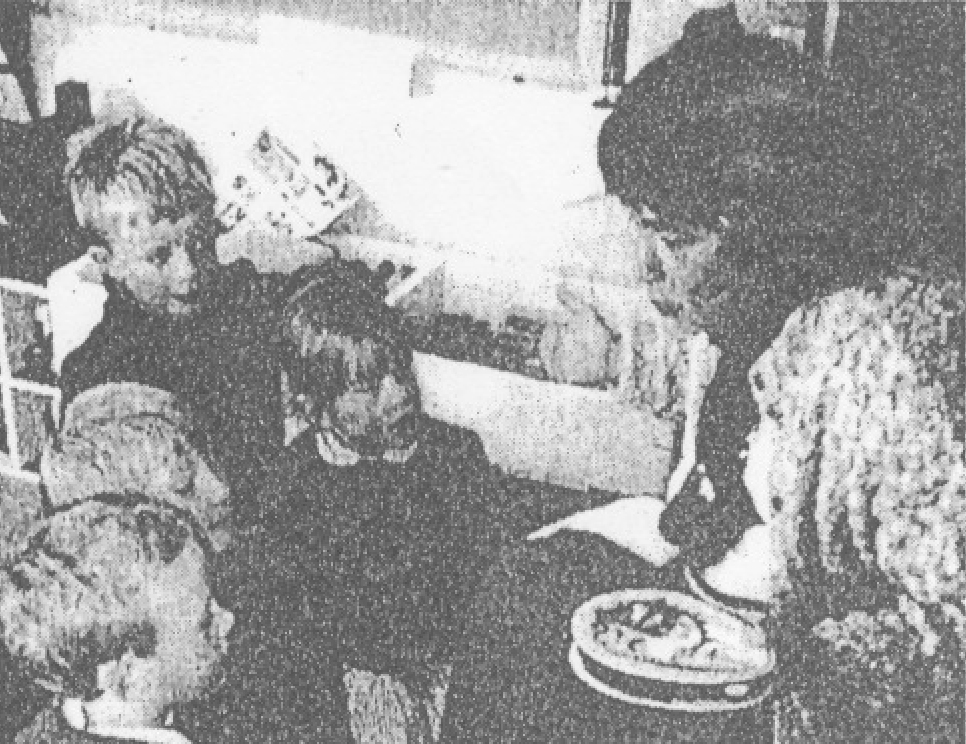Главная
Об этом сайте
Немного о себе
Стихи
Книги
Одна пьеса
Сказочный английский
Выступления
Интервью
Для газет1990 A story about storytelling
1991 Over here
1991 How to tell tall stories
1991 Empty shelves and English
1992 Storytelling in practice
1996 "- Закройте за мной рот!"
1997 "- Вы обозвали меня поэтессой?"
1998 "-Я всех люблю, и мне всех очень жалко"
1999 О Ренате, Мухармсе и платке хоботовом
2004 Рената Муха: начало следует..
2005 Птичьи права: прыгнуть с парашютом вверх...
На телевидении
На радио
Что было в газетах
Глазами друзей

How to tell tall stories Storytelling in class can be fun and productive. Русский перевод читать здесь. EFL Gazette, June 1991
Renata Tkachenko tells Paul Gander how it works.
Great interest has been aroused by the idea of class-room storytelling, but what would you say to the teacher who is unsure how it could help his or her learners?

“This depends on the class you have. For example, with an uninterested group of poor achievers a well-chosen and well-told story can do a very important thing: it can change the class’s attitude to the language to the extent that they fall in love with it. The story can introduce: or revise vocabulary in a natural setting and can bring different teaching points together. For example, in the Three Bears the vocabulary of house contents is revised while the present perfect continuous tense also crops up quite naturally.”
A story can involve pupils of different ability, with the possibility of graded activities.
“Communicative competence is recognised to be of paramount importance for children as for adults but creating the right context for children can be difficult. A story such as Mr Gumpy’s Outing by John Burningham can involve children sufficiently for them to identify with the characters and, in this case, practice asking permission. The exponents can be worked into the story memorably, convincingly and pleasantly”.
To the TEFLer trained in communicative methods such an apparently teacher-centred activity might seem difficult to justify, especially given your own preference for minimizing the use of visual aids.
“Yes, I do feel that visual aids tend to interrupt direct communication between teacher and learner. This process is vital to the success of the story, which must not be read out but told so that eye contact is maintained. Pair and group work can be used to involve the audience at all times. Repetition and suggestions from groups and individuals gradually take over and shift the focus away from the teacher”.
Let’s suppose that a teacher wants to tell a story, how does she go about choosing one?
“I personally use a restricted choice of stories: authentic, cumulative stories, with a lot of repetition, written in good natural language, with good euphonic effects and above all rhythm. One psychologist noticed that a clear rhythm encourages communication in children. Also, stories for telling rather than reading should have some sort of exposition which sets the scene and allows the listener to get into the story-telling mood.”
And how do these stories relate to other language work?
“Often teachers say there is no place in a traditional syllabus for storytelling. My answer is: ‘No there isn’t and so much the worse for the syllabus-there should be.’ The story can be used to introduce, reinforce or revise a new language point or vocabulary. With four- or five-year-olds storytelling can be used extensively and could probably even form the basis for the introductory stage of language teaching.”
But surely there are problems involved with telling stories to these very young children with no knowledge of the language?
“One way of overcoming this difficulty is mixed storytelling. The first time I used this technique, with a group of four-year-olds from Moor Park School, Ludlow, I told a Russian story in English. I began by introducing odd words of Russian and told the story three times over three consecutive days, each time bringing in more Russian words. By the third day the children were joining in to help me with the English and Russian parts of the story, which made it more like a game. This technique is described in more detail by Mario Rinvolucri in his book Vocabulary.
“When I came back six months later, invited by the British Council ELTECS scheme to do research into the techniques of story-telling, I had a chance to visit the school again. I was pleasantly surprised when they not only recognised me and asked me to tell them the same story, but also remembered all the words they had learned.
“With another group, this time of mature learners, I consciously used the mixed story-telling technique to teach some Russian. This was by way of illustration during lectures by Arlene Gilpin to her own Med students in the Bristlol School of Education. These students later acknowledged the great potential that story-telling has for encouraging communication.
“From my talking to other storytellers, such as Mario Rinvilucri, Edie Garvey, Andrew Wright and Gail Ellis, it is clear that however many different types of story-telling there are and whatever their shortcoming, it is an indispensable skill which should form part of ever language teacher’s training.”
Dr Tkachenko is Assistant Professor of English at the University of Kharkov and a member of the British Council ELTECS scheme.
